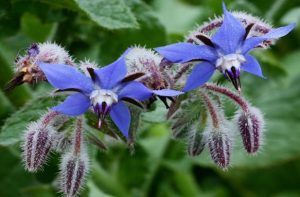By Debbie Roland
Master Gardener
I was surprised when I saw Borage for sale last spring since I haven’t seen it much in the past so I decided to do some research. I liked what I found and plan to plant some this year. It smells like cucumbers which definitely drew me in. Touted as easy and fast to grow it is considered an herb but is most often grown to draw pollinators into your garden, especially bees.
It is a companion plant for squash, strawberries and Texas favorite garden plant, tomatoes. Some gardeners use it to deter tomato worms and improve the flavor of tomatoes grown close by. It is an annual and self-seeds. Growing gangly and sporting star shaped flower clusters that face down it can deter insects. The stems are a gray green and have prickly fuzz with blue flowers. The leaves of this plant which contain pyrrolizidine alkaloids which can cause mild digestive issues to pets and people if eaten often. Use the flower and stem occasionally for flavor and not as a big part of your diet.

Also known as starflower and tailwort (Borago officinalis) it can grow from 1 to 3 feet tall with a 9 to 18 inch spread. Choose a location with full or partial sun and plant after the last frost by seed or transplant. They grow best in well-drained soil or in containers. Plant seeds 1/4 to 1/2 inch deep and thin to about 18 to 24 inches apart. Amending your soil with compost and other organic matter will give these plants a boost.
Keep soil moist while Borage is growing but once mature you can cut watering back to every few days. It is heat tolerant but can’t tolerate a frost. They reach maturity at about eight weeks and will decline if they are not deadheaded (removing old blooms). Plant several times throughout the season to ensure a longer harvest time. Harvest the flowers using scissors. The flowers are best eaten fresh adding color to drinks, ice cubes, soups and salads. The stalks are edible as well – use them like you would celery.
Borage has few pests but powdery mildew can occur. Make sure the plant has good air circulation and water properly to deter it.
At the end of the season pull plants and add them to your compost bin.
REMINDER: The Spring Symposium will be March 23 at the Midland AgriLife Office and will be from 9:30 a.m. to 2 p.m. with three speakers and lunch being provided all for just $20. You will learn more about what makes West Texas unique and how to deal with changing issues. Follow our Facebook page “Permian Basin Master Gardeners” and watch our articles here for additional details for registration. You’ll be glad you did.
If you have questions, call the AgriLife office in Odessa at 498-4071 or in Midland at 686-4700. Additional information, and our blog for access to past articles, is available at westtexasgardening.org. Click on “Resources.”




